突发性紧急事故处理程序(中英文)
应急处置流程英文
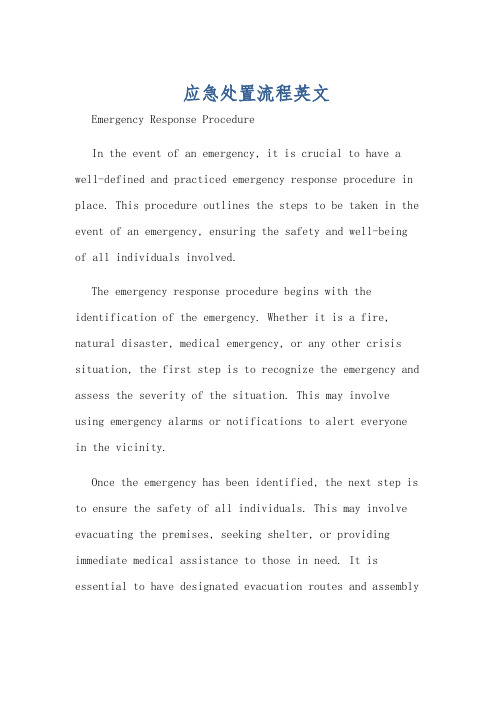
应急处置流程英文Emergency Response ProcedureIn the event of an emergency, it is crucial to have a well-defined and practiced emergency response procedure in place. This procedure outlines the steps to be taken in the event of an emergency, ensuring the safety and well-being of all individuals involved.The emergency response procedure begins with the identification of the emergency. Whether it is a fire, natural disaster, medical emergency, or any other crisis situation, the first step is to recognize the emergency and assess the severity of the situation. This may involve using emergency alarms or notifications to alert everyonein the vicinity.Once the emergency has been identified, the next step is to ensure the safety of all individuals. This may involve evacuating the premises, seeking shelter, or providing immediate medical assistance to those in need. It is essential to have designated evacuation routes and assemblypoints in place to ensure a swift and organized evacuation process.Communication is also a key component of the emergency response procedure. Designated individuals should be responsible for contacting emergency services, relaying important information to all individuals involved, and providing updates on the situation as it unfolds. This may involve using communication devices such as two-way radios, phones, or emergency notification systems.Following the initial response to the emergency, it is important to conduct a thorough assessment of the situation. This may involve conducting a headcount of all individualsto ensure that everyone is accounted for, assessing any injuries or medical needs, and evaluating the extent of any damage or impact caused by the emergency.Once the immediate response and assessment have been completed, the next step is to initiate any necessaryfollow-up actions. This may involve implementing measuresto prevent further harm or damage, coordinating with emergency services and authorities, and providing supportto those affected by the emergency.Regular drills and training exercises should be conducted to ensure that all individuals are familiar with the emergency response procedure and are prepared to act swiftly and effectively in the event of an emergency. This may involve practicing evacuation procedures, first aid skills, and communication protocols.In summary, the emergency response procedure is a critical component of any organization's safety and security measures. By having a well-defined procedure in place, individuals can respond effectively to emergencies, minimize harm and damage, and ensure the safety and well-being of all individuals involved.应急处置流程在发生紧急情况时,非常重要的是制定并实践良好的应急处置流程。
中英文 紧急情况反应程序模板 Emergency Response Procedure
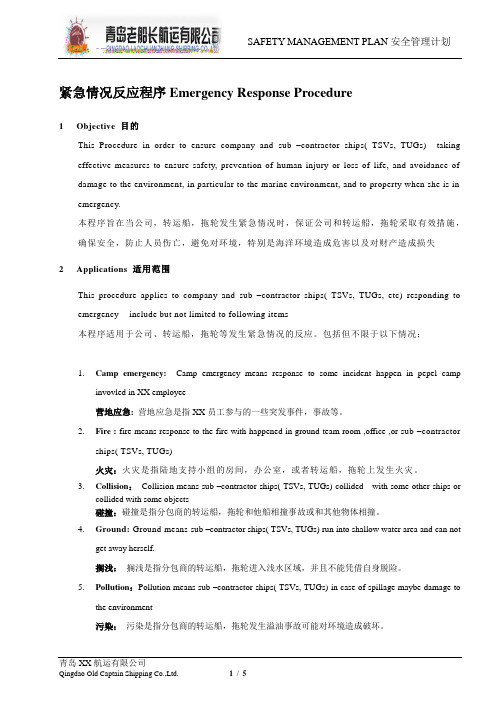
紧急情况反应程序Emergency Response Procedure1 Objective 目的This Procedure in order to ensure company and sub –contractor ships( TSVs, TUGs) taking effective measures to ensure safety, prevention of human injury or loss of life, and avoidance of damage to the environment, in particular to the marine environment, and to property when she is in emergency.本程序旨在当公司,转运船,拖轮发生紧急情况时,保证公司和转运船,拖轮采取有效措施,确保安全,防止人员伤亡,避免对环境,特别是海洋环境造成危害以及对财产造成损失2 Applications 适用范围This procedure applies to company and sub –contractor ships( TSVs, TUGs, etc) responding to emergency include but not limited to following items本程序适用于公司、转运船,拖轮等发生紧急情况的反应。
包括但不限于以下情况;1.Camp emergency: Camp emergency means response to some incident happen in pepel campinvovled in XX employee营地应急: 营地应急是指XX员工参与的一些突发事件,事故等。
2.Fire : fire means response to the fire with happened in ground team room ,office ,or sub –contractorships( TSVs, TUGs)火灾:火灾是指陆地支持小组的房间,办公室,或者转运船,拖轮上发生火灾。
(全面版)突发事件应急预案英文版
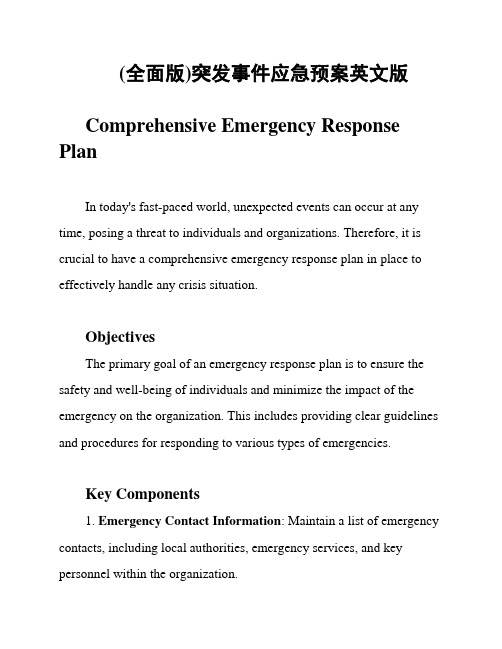
(全面版)突发事件应急预案英文版Comprehensive Emergency Response PlanIn today's fast-paced world, unexpected events can occur at any time, posing a threat to individuals and organizations. Therefore, it is crucial to have a comprehensive emergency response plan in place to effectively handle any crisis situation.ObjectivesThe primary goal of an emergency response plan is to ensure the safety and well-being of individuals and minimize the impact of the emergency on the organization. This includes providing clear guidelines and procedures for responding to various types of emergencies.Key Components1. Emergency Contact Information: Maintain a list of emergency contacts, including local authorities, emergency services, and key personnel within the organization.2. Communication Plan: Establish a communication protocol for notifying employees, stakeholders, and the public about the emergency situation.3. Evacuation Procedures: Develop clear evacuation routes and procedures for safely evacuating individuals from the premises.4. Emergency Supplies: Stock up on essential emergency supplies such as first aid kits, flashlights, and food/water rations.5. Training and Drills: Conduct regular training sessions and drills to ensure that employees are familiar with the emergency response plan.Response ProtocolIn the event of an emergency, the following steps should be followed:1. Assess the Situation: Quickly assess the nature and severity of the emergency to determine the appropriate response.2. Activate the Emergency Response Team: Notify the designated emergency response team to coordinate the response efforts.3. Implement the Response Plan: Follow the established procedures and guidelines outlined in the emergency response plan.4. Communicate Effectively: Keep all stakeholders informed about the situation and provide regular updates as necessary.5. Evaluate and Learn: After the emergency has been resolved, conduct a thorough review of the response efforts to identify areas for improvement.ConclusionA well-prepared emergency response plan is essential for effectively managing crisis situations and ensuring the safety of individuals. By following the key components and response protocol outlined in this document, organizations can mitigate the impact of emergencies and protect their assets.。
应急预案中英文

I. IntroductionThe Emergency Response Plan (ERP) is designed to provide a structured framework for the immediate and effective response to emergencies or disasters that may occur within our organization. This plan outlines the roles and responsibilities of all personnel involved, the procedures to be followed, and the communication channels to be used in order to minimize the impact of emergencies and ensure the safety of all individuals involved.II. ScopeThis ERP applies to all employees, contractors, and visitors within the organization. It covers a wide range of emergencies, including but not limited to fire, natural disasters (earthquakes, floods, etc.), chemical spills, medical emergencies, and active shooter situations.III. Emergency PreparednessA. Risk Assessment1. Conduct regular risk assessments to identify potential hazards and vulnerabilities within the organization.2. Develop and implement appropriate controls to mitigate identified risks.B. Training and Drills1. Provide regular emergency training sessions for all employees.2. Conduct emergency drills at least twice a year to ensure preparedness and familiarity with emergency procedures.IV. Emergency Response ProceduresA. General Procedures1. Immediate Response: Upon detection of an emergency, employees should immediately activate the emergency alarm and initiate the appropriate emergency response procedures.2. Evacuation: In the event of a fire or other emergency requiring evacuation, all employees should proceed to the designated assembly point(s) in an orderly and calm manner.3. First Aid: Designate individuals trained in first aid to provide immediate medical assistance to injured persons.4. Communication: Utilize the organization’s communication system to provide updates and instructions to all personnel.B. Specific Emergency Procedures1. Fire: Activate the fire alarm, evacuate the building, and report to the designated assembly point. Use fire extinguishers only if trained and safe to do so.2. Earthquake: Drop to the ground, cover your head and neck with your arms, and hold on to a sturdy object until the shaking stops.3. Chemical Spill: Evacuate the area, alert others, and report to the designated assembly point. Do not touch or inhale the chemical.4. Medical Emergency: Provide first aid as necessary, and call for emergency medical services immediately.5. Active Shooter: Seek shelter, if possible, and remain silent. Do not attempt to confront the shooter. Evacuate the area if safe to do so.V. Communication PlanA. Internal Communication1. Utilize the organization’s internal communication system to provide updates and instructions during emergencies.2. Designate a spokesperson to communicate with external authorities and the media.B. External Communication1. Notify local emergency services and other relevant authorities immediately upon detection of an emergency.2. Communicate with affected stakeholders, such as employees, customers, and suppliers, through appropriate channels.VI. Post-Emergency ResponseA. Assessment and Recovery1. Conduct a thorough assessment of the emergency’s impact on the organization.2. Develop and implement a recovery plan to restore normal operations as quickly as possible.B. Review and Improvement1. Review the effectiveness of the ERP and emergency response procedures.2. Make necessary adjustments to improve future emergency response capabilities.VII. ConclusionThis Emergency Response Plan is a living document that should be reviewed and updated regularly. By following the procedures outlined in this plan, our organization can effectively respond to emergencies and minimize their impact on our operations and personnel.中文版紧急应急预案一、引言紧急应急预案(ERP)旨在为组织内部可能发生的紧急情况或灾难提供结构化的应对框架。
突发疾病事件的处置流程
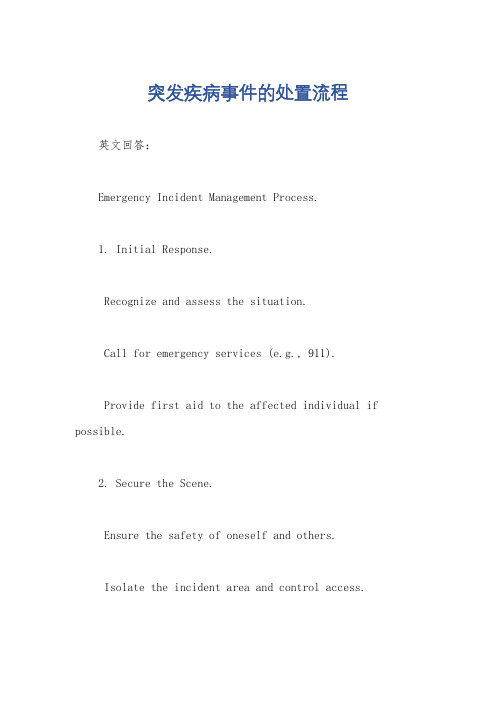
突发疾病事件的处置流程英文回答:Emergency Incident Management Process.1. Initial Response.Recognize and assess the situation.Call for emergency services (e.g., 911).Provide first aid to the affected individual if possible.2. Secure the Scene.Ensure the safety of oneself and others.Isolate the incident area and control access.Eliminate or minimize potential hazards.3. Gather Information.Collect details about the incident, including the nature of the illness, symptoms, and any relevant medical history.Obtain information from witnesses and the affected individual.4. Communicate with Emergency Services.Provide clear and concise information to emergency responders via phone or dispatch.Follow the instructions of the emergency services personnel.5. Monitor the Patient.Observe the patient's vital signs and conditionclosely.Provide ongoing support and reassurance.记录患者症状和治疗措施的任何变化。
中英文应急救援方案

Emergency Solutions and Rapid Response Mechanism 应急预案和快速反映机制*本预案中的详细信息将在项目实施前进一步完善并呈报相关部门(1)、Exigency Gather Point 紧急集合点Exigency Gather Point 紧急集合点While the emergency happen and the gather is necessary, all persons need go beinformed to gather at the Exigency Gather Point by safety Dept or guard Dept.在出现应急状态必需召集进行集合时,由安全数门或捍卫部门通知所有人员在集合点集合。
The location of the Exigency Gather Point need to be informed the person while they entering the site.集合点的位置应在进场时告知所有员工及外来人员。
The obvious sign should be at the location of the point, legend as the following:紧急集合点处应有明显标志,标志如下:(2)、Description 说明Emergency preparedness is the state of mind an occupier has to minimize the consequence of loss after an accident has takenplace. The objective of this element is to ensurethat the Company has developed andcommunicated plans that will allow for the effectivemanagement of emergencies.紧急情形预备状态是利用者在事故发生后必需把损失降低到最低程度的预备状态。
简述突发火灾事件报告流程
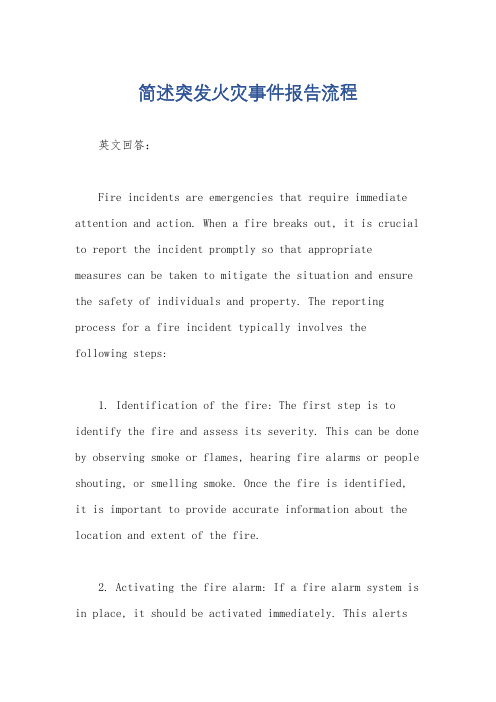
简述突发火灾事件报告流程英文回答:Fire incidents are emergencies that require immediate attention and action. When a fire breaks out, it is crucial to report the incident promptly so that appropriate measures can be taken to mitigate the situation and ensure the safety of individuals and property. The reporting process for a fire incident typically involves thefollowing steps:1. Identification of the fire: The first step is to identify the fire and assess its severity. This can be done by observing smoke or flames, hearing fire alarms or people shouting, or smelling smoke. Once the fire is identified,it is important to provide accurate information about the location and extent of the fire.2. Activating the fire alarm: If a fire alarm system is in place, it should be activated immediately. This alertseveryone in the vicinity and initiates the evacuation process. Pulling the fire alarm lever or pressing the emergency button will trigger the alarm and notify the relevant authorities.3. Calling emergency services: The next step is to call the emergency services, such as the fire department, and provide them with detailed information about the fire. This includes the address of the incident, the type of building or structure involved, and any specific hazards or risks that may be present. It is important to remain calm and provide clear and concise information to the operator.4. Evacuation: In the event of a fire, it is crucial to evacuate the premises as quickly and safely as possible. Follow the established evacuation procedures, which may include using designated escape routes, avoiding elevators, and assisting others who may need help. Once outside, move to a safe distance from the building and wait for further instructions from the authorities.5. Reporting to the designated personnel: Afterevacuating, it is important to report the fire incident to the designated personnel or authority. This may be a supervisor, a security guard, or any other responsible person who can ensure that the necessary actions are takento address the situation. Provide them with all therelevant information about the fire, including any injuries or missing persons.6. Documenting the incident: It is essential to document the fire incident for future reference and investigation. This can be done by taking photographs or videos of the scene, noting down any relevant details, and recording the names of witnesses or individuals involved. This information can be helpful in determining the cause of the fire and implementing preventive measures in the future.Overall, the process of reporting a fire incident involves quickly identifying the fire, activating the fire alarm, calling emergency services, evacuating the premises, reporting to designated personnel, and documenting the incident. By following these steps, the necessaryassistance can be provided promptly, ensuring the safety ofeveryone involved.中文回答:火灾事件是需要立即关注和采取行动的紧急情况。
突发事件应对-中英文
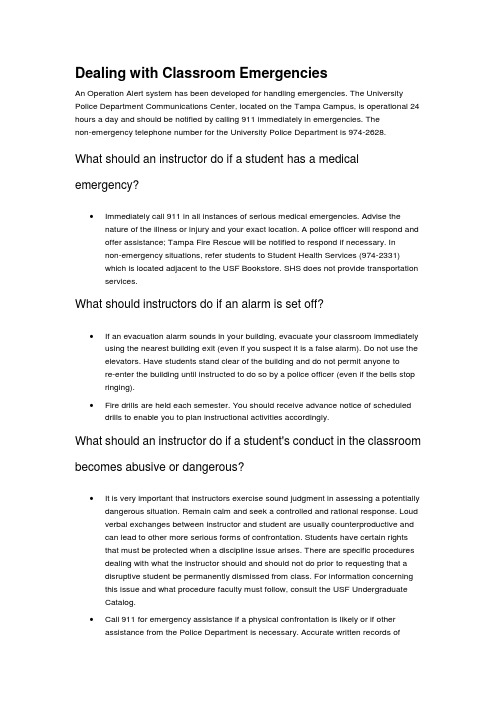
Dealing with Classroom EmergenciesAn Operation Alert system has been developed for handling emergencies. The University Police Department Communications Center, located on the Tampa Campus, is operational 24 hours a day and should be notified by calling 911 immediately in emergencies. Thenon-emergency telephone number for the University Police Department is 974-2628.What should an instructor do if a student has a medicalemergency?∙Immediately call 911 in all instances of serious medical emergencies. Advise the nature of the illness or injury and your exact location. A police officer will respond and offer assistance; Tampa Fire Rescue will be notified to respond if necessary. Innon-emergency situations, refer students to Student Health Services (974-2331)which is located adjacent to the USF Bookstore. SHS does not provide transportation services.What should instructors do if an alarm is set off?∙If an evacuation alarm sounds in your building, evacuate your classroom immediately using the nearest building exit (even if you suspect it is a false alarm). Do not use the elevators. Have students stand clear of the building and do not permit anyone tore-enter the building until instructed to do so by a police officer (even if the bells stopringing).∙Fire drills are held each semester. You should receive advance notice of scheduled drills to enable you to plan instructional activities accordingly.What should an instructor do if a student's conduct in the classroombecomes abusive or dangerous?∙It is very important that instructors exercise sound judgment in assessing a potentially dangerous situation. Remain calm and seek a controlled and rational response. Loud verbal exchanges between instructor and student are usually counterproductive andcan lead to other more serious forms of confrontation. Students have certain rightsthat must be protected when a discipline issue arises. There are specific proceduresdealing with what the instructor should and should not do prior to requesting that adisruptive student be permanently dismissed from class. For information concerningthis issue and what procedure faculty must follow, consult the USF UndergraduateCatalog.∙Call 911 for emergency assistance if a physical confrontation is likely or if other assistance from the Police Department is necessary. Accurate written records ofsignificant incidents must be kept and your Department Chairperson should beimmediately advised of the situation.课堂突发事件处理已经研发了运行预警系统来处理突发事件。
紧急情况处理程序
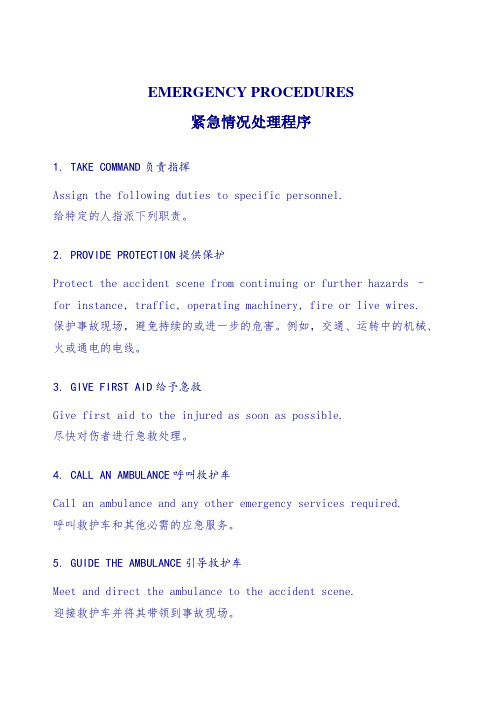
EMERGENCY PROCEDURES紧急情况处理程序1. TAKE COMMAND负责指挥Assign the following duties to specific personnel.给特定的人指派下列职责。
2. PROVIDE PROTECTION提供保护Protect the accident scene from continuing or further hazards – for instance, traffic, operating machinery, fire or live wires.保护事故现场,避免持续的或进一步的危害。
例如,交通、运转中的机械、火或通电的电线。
3. GIVE FIRST AID给予急救Give first aid to the injured as soon as possible.尽快对伤者进行急救处理。
4. CALL AN AMBULANCE呼叫救护车Call an ambulance and any other emergency services required.呼叫救护车和其他必需的应急服务。
5. GUIDE THE AMBULANCE引导救护车Meet and direct the ambulance to the accident scene.迎接救护车并将其带领到事故现场。
6. GET NAME OF HOSPITAL记住医院名称For follow-up, find out where the injured is being taken.搞清伤者被送往哪里,以便后续行动。
7. ADVISE MANAGEMENT通知管理部门(人员)Inform senior management. They can then contact relatives, notify authorities, and start procedures for reporting and investigating the accident. 通知高级管理人员。
发生事故应急处理流程,及上报流程

发生事故应急处理流程,及上报流程1.发生事故后,第一时间要确保人员安全。
Once an accident occurs, the first priority is to ensure the safety of personnel.2.紧急处理流程应当立即启动。
The emergency handling process should be initiated immediately.3.指定责任人组织事故应急处置工作。
Designated personnel should organize the emergency response work.4.确保伤者得到及时的救治和抢救。
Ensure that the injured receive timely medical treatment and rescue.5.此时应当采取措施防止事故的扩大。
Measures should be taken at this time to prevent the accident from escalating.6.封锁现场,维护现场秩序,保障事故调查的顺利进行。
Block the scene, maintain order at the scene, and ensure the smooth progress of the accident investigation.7.对于有人员伤亡的事故,要立即通知有关部门。
For accidents involving casualties, relevant departments must be notified immediately.8.对事故现场进行必要的记录和取证工作。
Necessary records and evidence collection should be carried out at the accident scene.9.根据事故的具体情况做出相应的处理和应急决策。
请简述突发紧急停电应发流程英语
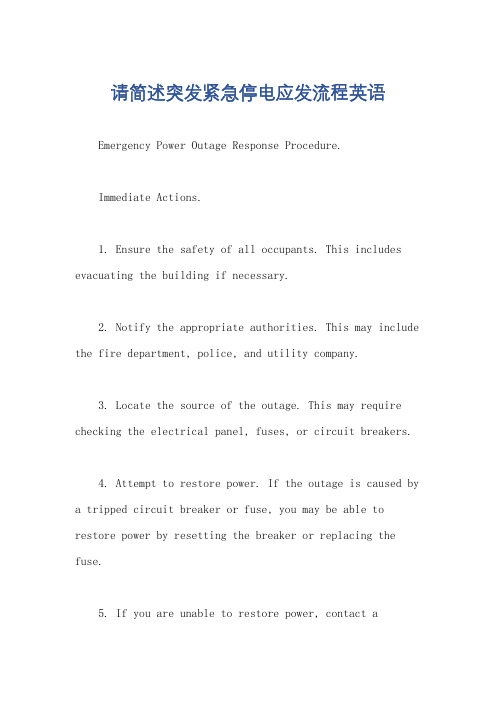
请简述突发紧急停电应发流程英语Emergency Power Outage Response Procedure.Immediate Actions.1. Ensure the safety of all occupants. This includes evacuating the building if necessary.2. Notify the appropriate authorities. This may include the fire department, police, and utility company.3. Locate the source of the outage. This may require checking the electrical panel, fuses, or circuit breakers.4. Attempt to restore power. If the outage is caused bya tripped circuit breaker or fuse, you may be able to restore power by resetting the breaker or replacing the fuse.5. If you are unable to restore power, contact aqualified electrician.Steps to Take After the Outage.1. Inspect all electrical equipment for damage. This includes checking for any signs of burning or overheating.2. If you find any damaged equipment, do not use it. Contact a qualified electrician to have it repaired or replaced.3. Check all food in your refrigerator and freezer. Food that has been thawed and refrozen may not be safe to eat. Discard any spoiled food.4. If you have a generator, follow the manufacturer's instructions for safe operation. Never operate a generator indoors, as this can lead to carbon monoxide poisoning.5. Stay informed about the outage. Listen to local news reports or check the utility company's website for updates on the outage.Additional Tips.Keep a flashlight and extra batteries on hand. This will come in handy if the outage occurs at night.Have a battery-powered radio on hand. This will allow you to stay informed about the outage and any emergency instructions.If you have a medical condition that requires electricity, such as a powered wheelchair or oxygen concentrator, make sure you have a backup plan in place. This may involve having a generator or staying with a friend or family member who has power.Emergency Power Outage Plan.In addition to the immediate actions and steps to take after an outage, it is also important to have an emergency power outage plan in place. This plan should include the following information:Contact information for the utility company and other emergency services.A list of essential items to have on hand, such as flashlights, batteries, a battery-powered radio, and afirst-aid kit.A plan for how to stay warm in the winter and cool in the summer.A plan for how to cook food and boil water.A plan for how to communicate with others in the event of a power outage.By following these tips and having an emergency power outage plan in place, you can help to ensure your safety and well-being in the event of a power outage.。
《安全事故处理流程》英文
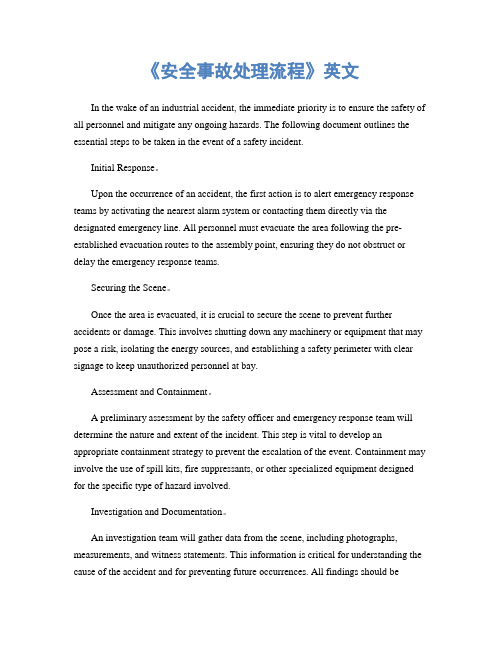
《安全事故处理流程》英文In the wake of an industrial accident, the immediate priority is to ensure the safety of all personnel and mitigate any ongoing hazards. The following document outlines the essential steps to be taken in the event of a safety incident.Initial Response。
Upon the occurrence of an accident, the first action is to alert emergency response teams by activating the nearest alarm system or contacting them directly via the designated emergency line. All personnel must evacuate the area following the pre-established evacuation routes to the assembly point, ensuring they do not obstruct or delay the emergency response teams.Securing the Scene。
Once the area is evacuated, it is crucial to secure the scene to prevent further accidents or damage. This involves shutting down any machinery or equipment that may pose a risk, isolating the energy sources, and establishing a safety perimeter with clear signage to keep unauthorized personnel at bay.Assessment and Containment。
发生事故后,简述紧急事故上报流程
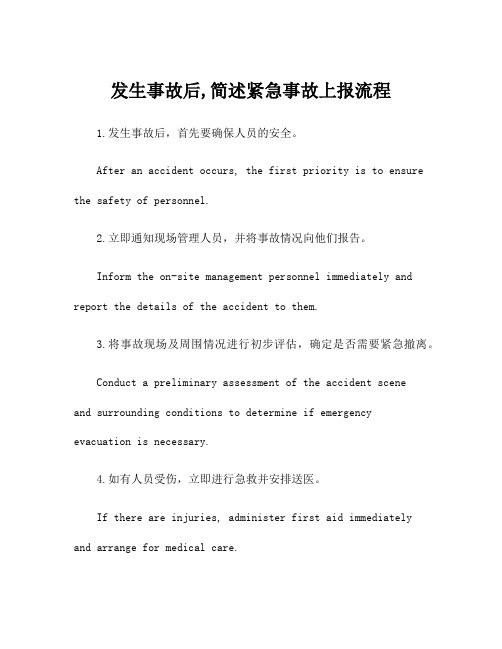
发生事故后,简述紧急事故上报流程1.发生事故后,首先要确保人员的安全。
After an accident occurs, the first priority is to ensure the safety of personnel.2.立即通知现场管理人员,并将事故情况向他们报告。
Inform the on-site management personnel immediately and report the details of the accident to them.3.将事故现场及周围情况进行初步评估,确定是否需要紧急撤离。
Conduct a preliminary assessment of the accident sceneand surrounding conditions to determine if emergency evacuation is necessary.4.如有人员受伤,立即进行急救并安排送医。
If there are injuries, administer first aid immediately and arrange for medical care.5.通知安全主管或相关领导,并提交事故报告。
Notify the safety supervisor or relevant leaders and submit an accident report.6.对事故现场进行隔离,确保现场不再造成二次伤害。
Isolate the accident scene to ensure that no further harm is caused.7.保留现场证据,不得随意移动或更改现场物品。
Preserve the scene of the accident and do not move or alter any items at the scene.8.尽快启动应急预案,迅速组织应急救援工作。
事故处理流程英文版详细步骤
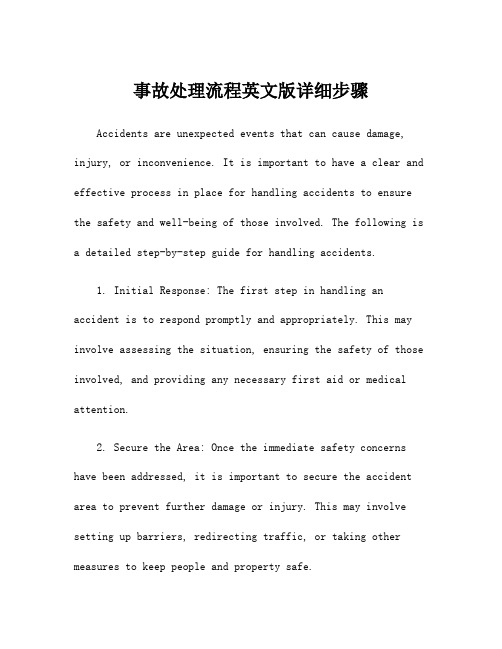
事故处理流程英文版详细步骤Accidents are unexpected events that can cause damage, injury, or inconvenience. It is important to have a clear and effective process in place for handling accidents to ensure the safety and well-being of those involved. The following isa detailed step-by-step guide for handling accidents.1. Initial Response: The first step in handling an accident is to respond promptly and appropriately. This may involve assessing the situation, ensuring the safety of those involved, and providing any necessary first aid or medical attention.2. Secure the Area: Once the immediate safety concerns have been addressed, it is important to secure the accident area to prevent further damage or injury. This may involve setting up barriers, redirecting traffic, or taking other measures to keep people and property safe.3. Gather Information: It is essential to gather as much information as possible about the accident. This may include taking photos, gathering witness statements, and collecting relevant documents or records.4. Notify Authorities: Depending on the nature and severity of the accident, it may be necessary to notify the appropriate authorities, such as law enforcement, emergency services, or regulatory agencies.5. Assess Damages: A thorough assessment of damages should be conducted to determine the extent of the impact and the necessary repairs or actions that need to be taken.6. Communication and Notification: It is important to communicate with all relevant parties, such as employees, customers, and the public, to provide information about the accident and any resulting impacts.7. Documentation and Reporting: Accurate documentation and reporting of the accident are crucial for record-keeping, insurance purposes, and legal requirements.8. Review and Learn: After the immediate aftermath of the accident has been addressed, it is important to conduct a thorough review of the incident to identify any lessons learned and opportunities for improvement.By following a clear and detailed accident handling process, organizations can effectively manage the impacts of accidents and work towards preventing future incidents. This not only helps to protect the safety and well-being of individuals, but also safeguards the reputation and operations of the organization.。
突发病应急处理流程
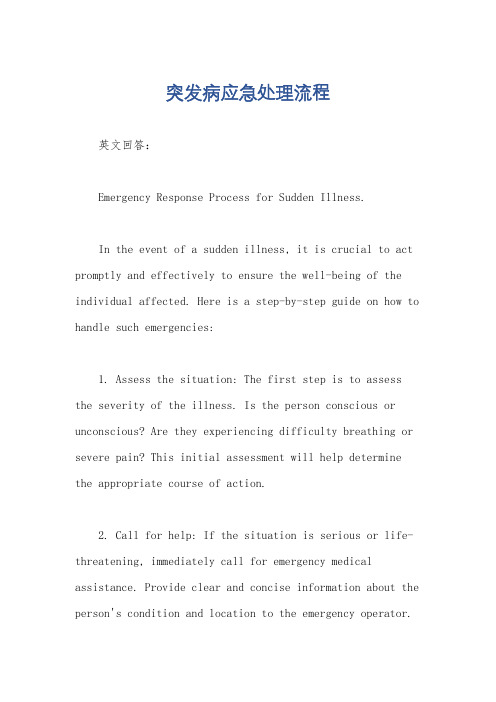
突发病应急处理流程英文回答:Emergency Response Process for Sudden Illness.In the event of a sudden illness, it is crucial to act promptly and effectively to ensure the well-being of the individual affected. Here is a step-by-step guide on how to handle such emergencies:1. Assess the situation: The first step is to assess the severity of the illness. Is the person conscious or unconscious? Are they experiencing difficulty breathing or severe pain? This initial assessment will help determine the appropriate course of action.2. Call for help: If the situation is serious or life-threatening, immediately call for emergency medical assistance. Provide clear and concise information about the person's condition and location to the emergency operator.3. Provide basic first aid: While waiting for medical professionals to arrive, administer basic first aid if you have the necessary knowledge and skills. For example, if the person is unconscious but breathing, place them in the recovery position to ensure their airway remains open.4. Follow medical instructions: Once medical professionals arrive, provide them with all relevant information about the person's symptoms and any actions taken. Follow their instructions carefully and cooperate fully to ensure the best possible care for the individual.5. Maintain calm and comfort: During the emergency response, it is important to remain calm and provide comfort to the person affected. Reassure them that help is on the way and stay by their side until medical professionals take over.6. Document details: After the situation has been resolved, it is crucial to document all relevant details regarding the incident. This includes the time theemergency occurred, the actions taken, and any observations made. This information may be useful for future referenceor in case of any follow-up medical care.中文回答:突发病应急处理流程。
解决突发事件的流程
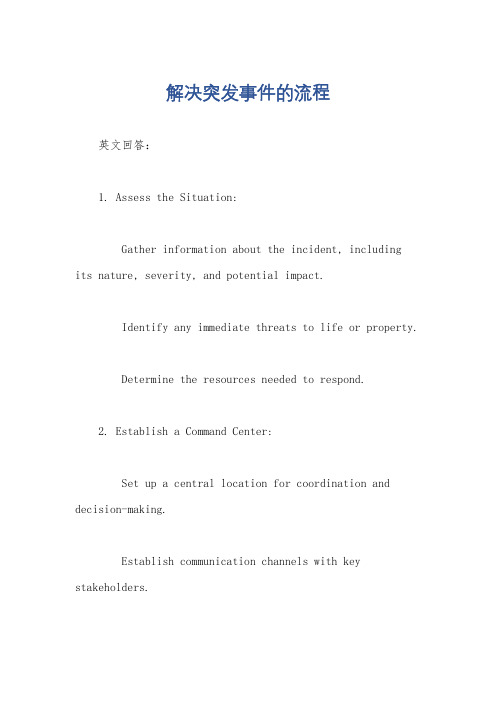
解决突发事件的流程英文回答:1. Assess the Situation:Gather information about the incident, includingits nature, severity, and potential impact.Identify any immediate threats to life or property.Determine the resources needed to respond.2. Establish a Command Center:Set up a central location for coordination and decision-making.Establish communication channels with key stakeholders.Delegate responsibilities to designated personnel.3. Activate the Response Team:Identify the appropriate personnel and equipmentfor the incident.Deploy responders to the scene and establish a safe working area.Provide support and guidance to responders.4. Implement Response Actions:Execute the appropriate response plan based on the incident type.Contain the incident, mitigate its impact, and protect life and property.Provide necessary medical treatment, evacuate personnel, or secure the area.5. Monitor and Adjust Response:Regularly assess the situation and gather updated information.Adjust response strategies as needed based on changing circumstances.Communicate changes to responders and stakeholders.6. Document and Report:Record all actions taken during the incident response.Prepare a detailed incident report for further analysis and improvement.7. Conduct After-Action Review:Review the incident response and identify areas forimprovement.Conduct training and exercises to enhance response capabilities.中文回答:1. 评估情况:收集事故信息,包括性质、严重程度和潜在影响。
突发事件处置预案英文
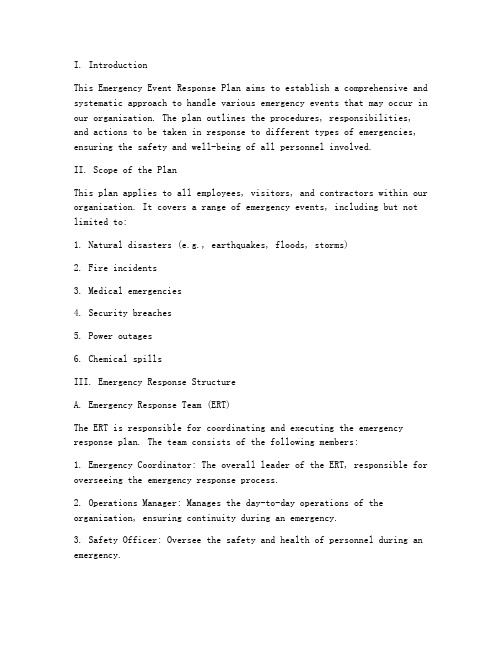
I. IntroductionThis Emergency Event Response Plan aims to establish a comprehensive and systematic approach to handle various emergency events that may occur in our organization. The plan outlines the procedures, responsibilities, and actions to be taken in response to different types of emergencies, ensuring the safety and well-being of all personnel involved.II. Scope of the PlanThis plan applies to all employees, visitors, and contractors within our organization. It covers a range of emergency events, including but not limited to:1. Natural disasters (e.g., earthquakes, floods, storms)2. Fire incidents3. Medical emergencies4. Security breaches5. Power outages6. Chemical spillsIII. Emergency Response StructureA. Emergency Response Team (ERT)The ERT is responsible for coordinating and executing the emergency response plan. The team consists of the following members:1. Emergency Coordinator: The overall leader of the ERT, responsible for overseeing the emergency response process.2. Operations Manager: Manages the day-to-day operations of the organization, ensuring continuity during an emergency.3. Safety Officer: Oversee the safety and health of personnel during an emergency.4. Communications Manager: Manages communication with all stakeholders, including internal and external entities.5. Logistics Manager: Coordinates resources, transportation, and other logistical support.6. Medical Officer: Provides medical assistance and guidance during emergencies.B. Emergency Response Procedures1. Activation of the PlanUpon the occurrence of an emergency event, the Emergency Coordinator will assess the situation and decide whether to activate the emergency response plan. If deemed necessary, the Emergency Coordinator will notify the ERT members and initiate the following procedures.2. Evacuation and Shelter-in-PlaceIn case of fire, chemical spills, or other situations requiring immediate evacuation, the ERT will coordinate the evacuation process. During an evacuation, all personnel must follow the designated evacuation routes and assemble at the designated safe area. In certain situations, the ERT may implement a shelter-in-place policy, requiring personnel to remain in their current location until further notice.3. CommunicationThe Communications Manager will ensure effective communication with all stakeholders. This includes:- Updating the organization's internal communication channels (e.g., email, intranet, and social media)- Notifying emergency services and other relevant authorities- Providing information to visitors and contractors4. First Aid and Medical AssistanceThe Medical Officer will coordinate first aid and medical assistance for injured personnel. In the event of a medical emergency, the following steps should be taken:- Provide immediate first aid to the injured person- Call emergency medical services if necessary- Transport the injured person to a nearby medical facility5. Damage Assessment and RestorationThe Operations Manager will assess the extent of damage to the organization's facilities and coordinate with relevant authorities to restore services. This includes:- Coordinating with utility companies for power and water supply restoration- Assisting with insurance claims and other related matters- Restoring normal operations as quickly as possible6. Post-Emergency ActivitiesFollowing the resolution of the emergency event, the ERT will conduct a thorough review and evaluation of the response. This includes:- Documenting lessons learned and best practices- Updating the emergency response plan based on the evaluation- Providing feedback and training to employeesIV. Training and DrillsTo ensure the effectiveness of the emergency response plan, all personnel should receive appropriate training and participate in regular drills. The training will cover the following topics:- Emergency response procedures- Evacuation and shelter-in-place protocols- First aid and medical assistance- Communication strategiesV. AppendicesThe appendices of this plan include the following:1. Emergency contact information2. Evacuation routes and assembly points3. First aid and medical assistance guidelines4. Emergency response plan updatesVI. ConclusionThis Emergency Event Response Plan is designed to ensure the safety and well-being of all personnel during emergency events. By following the outlined procedures and responsibilities, our organization can effectively respond to various emergencies and minimize potential risks. Regular training and drills will further enhance our preparedness and response capabilities.。
突发性事件应急预案
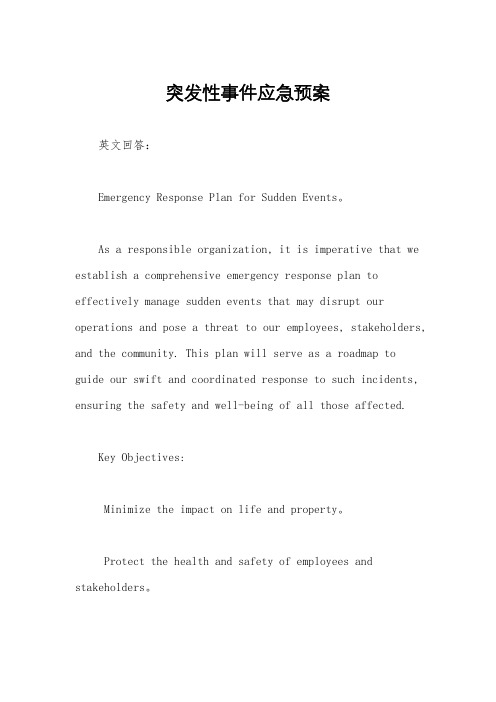
突发性事件应急预案英文回答:Emergency Response Plan for Sudden Events。
As a responsible organization, it is imperative that we establish a comprehensive emergency response plan to effectively manage sudden events that may disrupt our operations and pose a threat to our employees, stakeholders, and the community. This plan will serve as a roadmap to guide our swift and coordinated response to such incidents, ensuring the safety and well-being of all those affected.Key Objectives:Minimize the impact on life and property。
Protect the health and safety of employees and stakeholders。
Maintain business continuity and minimize disruptions。
Communicate effectively with stakeholders and the public。
Cooperate with emergency response agencies and other relevant organizations。
Scope:This plan applies to all sudden events that could potentially occur at our facilities or within our areas of operation. Such events may include, but are not limited to:Natural disasters (e.g., earthquakes, floods, hurricanes)。
紧急应变程序Emergency response process
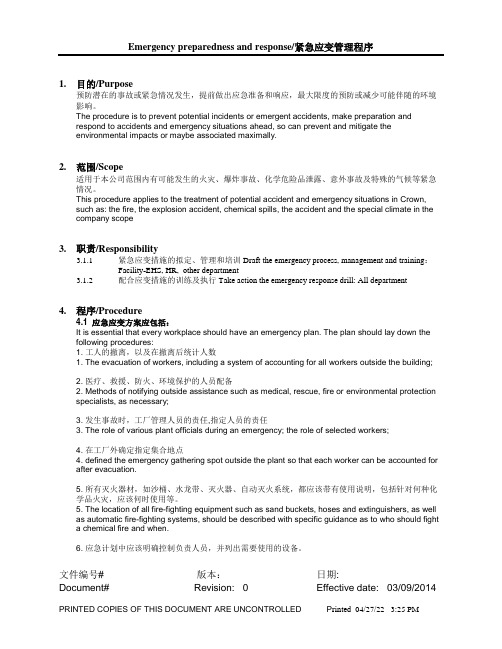
1.目的/Purpose预防潜在的事故或紧急情况发生,提前做出应急准备和响应,最大限度的预防或减少可能伴随的环境影响。
The procedure is to prevent potential incidents or emergent accidents, make preparation andrespond to accidents and emergency situations ahead, so can prevent and mitigate theenvironmental impacts or maybe associated maximally.2.范围/Scope适用于本公司范围内有可能发生的火灾、爆炸事故、化学危险品泄露、意外事故及特殊的气候等紧急情况。
This procedure applies to the treatment of potential accident and emergency situations in Crown, such as: the fire, the explosion accident, chemical spills, the accident and the special climate in the company scope3.职责/Responsibility3.1.1紧急应变措施的拟定、管理和培训 Draft the emergency process, management and training:Facility-EHS, HR, other department3.1.2配合应变措施的训练及执行Take action the emergency response drill: All department4.程序/Procedure4.1 应急应变方案应包括:It is essential that every workplace should have an emergency plan. The plan should lay down the following procedures:1. 工人的撤离,以及在撤离后统计人数1. The evacuation of workers, including a system of accounting for all workers outside the building;2. 医疗、救援、防火、环境保护的人员配备2. Methods of notifying outside assistance such as medical, rescue, fire or environmental protectionspecialists, as necessary;3. 发生事故时,工厂管理人员的责任,指定人员的责任3. The role of various plant officials during an emergency; the role of selected workers;4. 在工厂外确定指定集合地点4. defined the emergency gathering spot outside the plant so that each worker can be accounted forafter evacuation.5. 所有灭火器材,如沙桶、水龙带、灭火器、自动灭火系统,都应该带有使用说明,包括针对何种化学品火灾,应该何时使用等。
- 1、下载文档前请自行甄别文档内容的完整性,平台不提供额外的编辑、内容补充、找答案等附加服务。
- 2、"仅部分预览"的文档,不可在线预览部分如存在完整性等问题,可反馈申请退款(可完整预览的文档不适用该条件!)。
- 3、如文档侵犯您的权益,请联系客服反馈,我们会尽快为您处理(人工客服工作时间:9:00-18:30)。
Unexpected Event Handling Procedures
突发性紧急事故处理程序
(C-TPAT/GSV反恐)
1 Purpose 目的
The purpose of these procedures is to define how employees should report unexpected events to relevant departments and security personnel in an accurate and timely manner; to ensure that unexpected events are handled in a timely manner to minimize their hazard or damage to file and property.
本程序的目的是明确突发性紧急事故时,本公司员工如何及时把突发紧急事故准确的汇报给相关主管部门及相关的主管安全人员,确保突发紧急事故事件得到及时处理,把紧急事故对生命、财产构成的危险减到最少。
2 Procedure 1 程序 1
Reportable unexpected events include: theft of goods, containers and trailers; unauthorized entry of transport vehicles and personnel; deliberate sabotage to corporate property and personal safety; fire alarm; fighting between employees; work-related injuries and sudden disease attack to employees.
突发性紧急事故汇报事件包括:货物、集装箱、拖车失窃事件;非准许运输车辆、人员撞入事件;有预谋破坏公司财产、侵犯工人安全件;火警事故;员工打斗事件;员工工伤、突发生病事件等。
3 Procedure 2程序 2
In case of any accident, employees engaged in production in factory should report to supervisors immediately.
凡在厂内生产的员工,当有事故发生时,应立即向部门主管汇报。
4 Procedure 3 程序 3
In case of any accident, employees living in living zone should report to security guards on duty immediately.
凡在生活区域里的员工,当有紧急事故发生时,应立即向值班安全保安员汇报。
5 Procedure 4 程序 4
After receiving such reports from employees, department supervisors or security guards on duty should immediately report the same to security officer.
当部门主管或值班保安员接到员工紧急事故的事件汇报后,应立即把紧急事故情况汇报给安全主任。
6 Procedure 5 程序 5
In case of unexpected events, security guards on duty should immediately report the same to security officer.
当安全保安员在值班时发生紧急事故,当班保安员应立即把紧急事件的情况及时汇报给安全主任。
7 Procedure 6 程序 6
After receiving such reports, security officer should, in case of serious case, immediately report to local law-enforcing authorities and report details of 24 such unexpected to customers’ security super visors within 24 hours.
当安全主任接到紧急事故的事件汇报后,如事态严重,应立即向当地法律执行部门汇报,并在事故发生后的24小时内把事件经过汇报给客户安全主管人员。
8 Contact List 汇报联系人名单
Security officer: Hoi Guan 安全主任:关艳开
Department in-charge: German Cheung 部门经理:张岷
9 Telephone Number for Emergency Calls: 紧急联系电话号码:
Police 110 报警110
Fire brigade 119 火警119。
